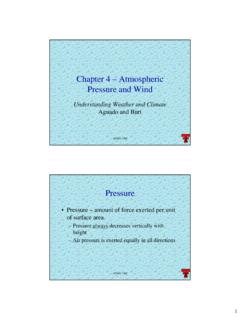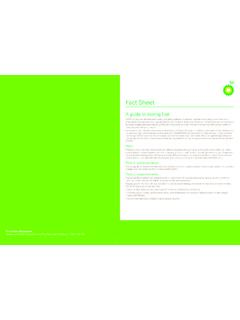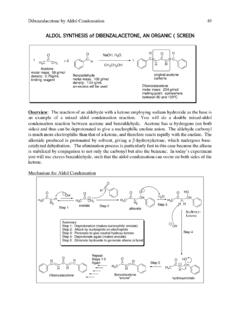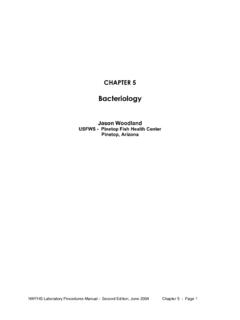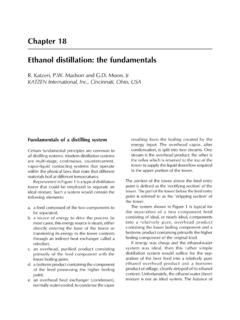Transcription of Chapter 5 - Atmospheric Moisture
1 1 ATMO 1300 Chapter 5 - Atmospheric MoistureUnderstanding Weather and ClimateAguado and BurtATMO 1300 Water Water Vapor - water in a gaseous form, not droplets. Water can also achieve solid and liquid phases on Earth Temperature and pressure Saturation The maximum amount of water that can exist in the atmosphere as a 1300 Evaporation and condensation Evaporation Change in phase from liquid to vapor. The process in which molecules break free of the liquid volume. condensation Change in phase from vapor to liquid. The process whereby molecules collide with the water surface and bond with adjacent molecules. ATMO 1300 Evaporation and Condensation3 ATMO 1300 Sublimation and Deposition Sublimation - Change of phase from a solid into a vapor without passing through the liquid phase. Deposition Change of phase from vapor to 1300 Humidity Humidity an expression of the amount of water vapor in the air.
2 There are several ways to measure humidity: Vapor Pressure (Pressure) Absolute Humidity (Density) Specific Humidity (Mass Ratio) Mixing Ratio (Mass Ratio) Relative Humidity (Percentage) Dew Point Temperature (Temperature) 4 ATMO 1300 Vapor Pressure Vapor Pressure The part of the total Atmospheric pressure due to water vapor. Dependencies: Temperature Unit: Pascal (Pa), millibar(mb), Kilopascal (kPa)ATMO 1300 Saturation Vapor Pressure The vapor pressure of the atmosphere when it is saturated. Dependencies: Temperature5 ATMO 1300 Absolute Humidity Absolute Humidity The density of water vapor (mass of water vapor in a volume of air). Dependencies: Volume of the air Not widely 1300 Specific Humidity Specific Humidity- The mass of water vapor per unit mass of air.
3 Dependencies: Atmospheric pressure Units: grams per kilogram (g/kg) Widely used q=specific humidity, mv=mass of water vapor, md=mass of dry air)(dvvvmmmmmq+==6 ATMO 1300 Mixing Ratio Mixing Ratio - The mass of water vapor relative to the mass of the other gases. Offers same advantages as specific humiditydvmmr=ATMO 1300 Relative Humidity Relative Humidity The amount of water vapor in the air relative to the maximum amount possible. Dependencies: Temperature Unit: percentage (%) Widely used, but not necessarily good7 ATMO 1300 Relative HumidityATMO 1300 Relative Humidity8 ATMO 1300 Dew Point Dew Point The temperature at which saturation would occur. Unit: F, C, K Widely usedATMO 1300 Dew Point9 ATMO 1300 Dew Point Vs. Relative HumidityATMO 1300 Three Ways to Achieve Saturation Adding water vapor to the air Lowering the temperature to the dew point Mixing cold air with warm, moist 1300 Mixing of Air ParcelsATMO 1300 Effects of Curvature Smaller drops have more curvature.
4 The evaporation rate from curved surfaces is higher relative to those which are flat. Curved water droplets have a higher saturation vapor pressure. Supersaturation (relative humidity greater than 100%) is necessary to maintain highly curved 1300 Effects of CurvatureATMO 1300 Effects of Solution Fewer water molecules existing at the surface which yield a lower evaporation rate. A solution requires less water vapor above the surface to stay in equilibrium. Offset the curvature effect allowing for droplets to form with relative humiditiesnear 100%.12 ATMO 1300 Ice Nuclei Saturation occurring from 0 to 4 C forms only supercooled water droplets. From 10 to 40 C ice or supercooledwater droplets can form. Below 40 C saturation leads to only the formation of ice crystals. Ice nuclei Particles onto which ice crystals can form when the air becomes 1300 Cooling Air to the Dew Point Heating/cooling can occur in two ways.
5 Diabatic processes Energy is removed or added. Adiabatic processes Energy is notadded or removed (energy remains constant).13 ATMO 1300 Diabatic Processes Involves the transfer of energy from higher to lower temperatures. Second Law of Thermodynamics Energy moves from regions of higher to lower temperatures. Frequently responsible for fog formationATMO 1300 Adiabatic Processes Energy remains constant (no heat transfer). First Law of Thermodynamics if heat is added there will be some combination of temperature increase and expansion. For an adiabatic process:TcpHv + = Tcpv + = 0 Tcpv = 14 ATMO 1300 Lapse Rates Dry adiabatic lapse rate (DALR) Rate at which rising parcel of unsaturated air cools. ( C/100 m) Saturated adiabatic lapse rate (SALR) - Rate at which rising parcel of saturatedair cools. ( C/100 m) Dew point lapse rate Rate at which dew point decreases with height.
6 ( C/100 m) Environmental lapse rate (ELR) Vertical change in temperature profile through still 1300 Lapse Rates15 ATMO 1300 Lapse Rates Difference between ELR and DALR/SALRATMO 1300 Lifting condensation Level LCL: Lifting condensation Level -level at which saturation is achieved 16 ATMO 1300 Forms of condensation Dew Frost Frozen Dew Fog Radiation Advection UpslopeATMO 1300 Fogs
